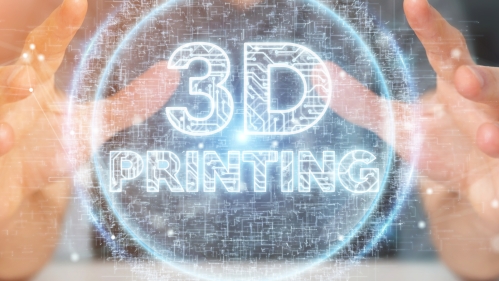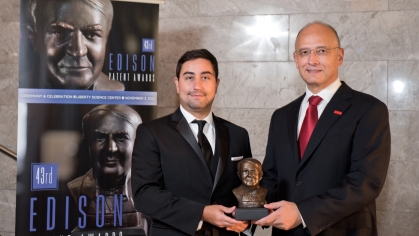Students Revolutionize 3D Printing

New 3D printing process offers unique capabilities
Rajiv Malhotra, an assistant professor in the School of Engineering Department of Mechanical and Aerospace Engineering (MAE), describes advanced manufacturing as an exciting research area that enables cutting edge innovation across multiple applications.
Most recently, a trio of students in Malhotra’s lab has created a new, cost-effective 3D printing process based on an idea he originated. “We are breaking new ground in 3D printing,” says second-year doctoral student Jeremy Cleeman. “Our process can greatly reduce the time and cost of 3D printing while expanding production capacity.”
A Breakthrough Process
Since its invention in the 1980s, manufacturers have saved energy and time, by turning to 3D printing to produce three-dimensional products. Based on a 3D digital file blueprint, the 3D printer deposits layer upon layer of material – from plastic and resins to metal powders and paper – to build an object.
Because current 3D printers deposit material with only a single nozzle, according to Malhotra, they “must compromise between speed and resolution, which is a key impediment to achieving scalability.”
“Our 3D printing process realizes a breakthrough by allowing manufacturers to print resolution-limited large and small parts at the same time, on the same machine, at unprecedented speed.”
Cleeman notes that, “This is accomplished by using a bunch of nozzles – instead of just one nozzle -- to simultaneously print multiple parts or distinct sections of the same part. Our printer is controlled via an algorithm that we developed ourselves.”
Their method of depositing material is unique. The printer’s capability to turn material deposition on and off while the printer is moving was developed by Alex Bogut, who began working in Malhotra’s lab in the summer of 2021 as an undergraduate. He started in the doctoral program after receiving his SoE bachelor’s degree in 2021, and intends to continue working on the project through the course of his PhD.
“This is a capability that 3D printers do not have today,” Bogut says. “It will hopefully become the standard for 3D printers since it allows novel cost and time margins.”
In addition to Bogut and Cleeman, MAE senior Brijesh Mangrolia, whose interest in additive manufacturing blossomed when he acquired a personal 3D printer, has played a key role in modeling the new process. “My primary role was developing the models to simulate temperature evolution in our multi-nozzle 3D printer,” he reports.
Excited to be able to assist in the development of a de novo manufacturing process, Mangrolia says he looks forward to seeing “how this process will translate to the real world in comparison to other large area additive manufacturing techniques.”
Patent Pending
The team’s success, which includes an accepted conference paper and upcoming journal papers, has been supported by Rutgers University research funds for the purchase of some essential equipment.
Additionally, Malhotra is the lead inventor and Bogut and Cleeman are co-inventors of a pending patent for the process. They are currently looking to commercialize this new process.
“We hope to turn it into a startup company in the near future,” says Malhotra. “And we’re looking for bright, enterprising students – ranging from sophomores to rising seniors and graduate students – with capabilities and interests in 3D printing to join our team.”


